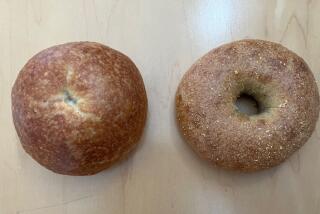Thinking on Matters of Lasting Insignificance
- Share via
Never in his wildest dreams, not even while teaching a college course on soap operas, did David Feldman think that one day his contribution to literature would be solving such profound mysteries as what causes the holes in Swiss cheese.
“I’m the kind of person who tosses and turns in bed at night, not over such things as nuclear disarmament, but over which fruits are in Juicy Fruit chewing gum,” Feldman said while visiting the Pacific Palisades home of his parents.
“The trouble was that when I woke up in the morning, all I had was a vague and nagging anxiety. I could never remember what had been troubling me.”
It happened that three years ago, the Manhattan resident was on a cereal kick. “In looking at the boxes morning every morning, I came to realize that for some reason--in nearly every brand--the calories were listed as 110 per ounce.
“Also, in a restaurant, I observed a gentleman in a conservative blue suit order a bowl of soup. When it arrived, he struggled to open the little pack of crackers with his fingers, as we all do. Finally, he looked around furtively, and tore the thing open with his teeth.
“If we can put a man on the moon,” I wondered, “why can’t we make cracker packages that are easy to open.”
Thus was set in motion “Imponderables,” a 262-page book by Feldman (published by William Morrow & Co., $12.95), which gives a lot of answers to some of the mysteries of life.
For instance, what about the burning question as to just which fruits are in Juicy Fruit chewing gum?
Obviously, the Wrigley executives weren’t about to tell all--but they did provide the author with a list of the predominant flavorings: Lemon, orange, pineapple and banana.
“I got a letter from a chemistry major in Florida who said he had tried to duplicate the overall flavor using only pineapple and banana, but that he couldn’t stabilize the flavor,” Feldman said. “It was his opinion that the company uses citrus, perhaps lemon and orange, for stabilizing.”
Not every attempt in this great compilation met with success. “I wanted to include the answer as to why hand-held paper hole punchers produce holes smaller than those in ready-made loose-leaf paper. Manufacturing these hole punchers isn’t one of the growth industries, but I was able to locate and call two such companies in two small towns.
“You would think I was Woodward or Bernstein. Everybody at both companies was very suspicious. They said things like ‘no comment,’ and to this day I don’t have my answer.”
Another imponderable on which the writer struck out was why--especially on rural roads--an occasional shoe is seen at the side.
“I even talked with the transportation people in Washington,” Feldman said. “Everybody knew about the shoes, but nobody could come up with an answer. Once when I was on a radio show I learned of two theories: Either they had been shoes discarded from the back of newlyweds’ cars, or they had been tossed out of school buses.”
More than 100 enigmas, however, are successfully dealt with in the book, one of them regarding the holes in Swiss cheese. After consulting an advisory council for the makers, the author was able to write:
“The cheese industry prefers to call these openings eyes rather than holes. The eyes are created by expanding gases that are emitted by a bacterium known as the eye former. The eye former is introduced during the early stages of Swiss cheese production.”
As for the generally uniform 110 calories per ounce in cereal, he explained:
Grains and Sweeteners
“Cereals are usually composed of two kinds of carbohydrates--grains and sweeteners, and both contribute exactly four calories per gram. One way the calorie count can be dropped is by adding fiber.”
Regarding the great issue of cracker packs, Feldman spoke with a nationally known manufacturer and learned that the former red tear strip caused problems on the production line. Besides, it never worked as well in practice as it did in theory. Some packs now come with serrated edges to facilitate tearing.
The question that resulted in the most interviewing was for one of civilization’s overwhelming puzzles: Why do women open their mouths when applying mascara?
“I went to department store beauty demonstrations, I asked employees at cosmetics companies, plastic surgeons, women in all walks of life--more people were contacted than for any other part of the book,” Feldman said. “Everybody had an answer, but nobody had the answer.”
One theory proposes that women open their mouths when applying mascara to better concentrate on the delicate balancing act of working around the eye, another theory that it helps avoid blinking, another that opening the mouth seems to relax the face and make the application less laborious, still another that it tightens muscles and puts the eyelid skin on a stretch (much as men make jaw contortions to make neck shaving easier).
On another matter of lasting insignificance, “Imponderables” tackled the keen question of why dinner knives have rounded edges:
Sharpening of Points
Turns out they used to have sharpened points--until the 17th Century, when Cardinal Richelieu objected to a house guest who used the point of his knife as a toothpick. Richelieu ordered his steward to round the ends of all the cardinal’s knives--and the cutlery style caught on.
Perhaps in some inscrutable way it figured that a literature major at Grinnell College, who went on to join the faculty at Bowling Green State University and teach what he said was the first-ever college credit course on soap operas, would become the oracle for the strange thinkers of the world.
Why don’t penguins in the Antarctic get frostbite on their feet? Why is a mile 5,280 feet? Why don’t cats like to swim?
More to Read
Sign up for our Book Club newsletter
Get the latest news, events and more from the Los Angeles Times Book Club, and help us get L.A. reading and talking.
You may occasionally receive promotional content from the Los Angeles Times.









